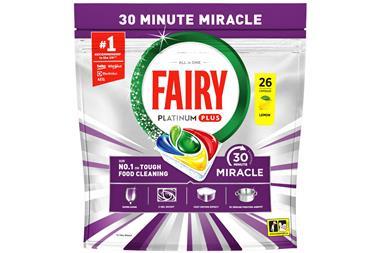A majority of young grocery managers believe that television's grip on advertising is slipping. Echoing the recently expressed views of Nestlé Rowntree's marketing director Andrew Harrison, 57% of Leading Edge members questioned for The Grocer said TV was a less effective medium for advertisers than it used to be, while supermarkets were gaining an edge.
Targeting specific consumer groups through TV advertising was becoming increasingly difficult because the number of channels was growing, diluting audiences.
Above-the-line advertising such as TV was the domain of the big brands. Those that cannot afford to keep up are turning more to below-the-line methods, they said.
The survey questioned 165 members on point of purchase (PoP) advertising. Of the respondents 60% were manufacturers and 20% were retailers.
Just under 30% believed TV maintained its effectiveness and raised doubts about PoP material. As one said: "We have all walked by an instore message because it has no personal appeal, but how many of us have switched off the TV because of an advert we don't like? TV has a captive audience."
Just under 60% of those surveyed thought manufacturers were allocating more of their advertising spend to stores and the replies indicated that some found it increasingly effective to use point of purchase promotions to communicate messages about non-branded goods, such as produce. "The cost of shelf barkers, posters and free leaflets is reasonable and allows us to reach huge numbers of people," said one respondent.
Sixty per cent said it was harder to get PoP material into stores, while 19% of respondents thought that PoP instore compliance levels were improving. So how much instore promotion is wasted? One respondent said: "An unbelievable amount of money seems to be wasted on PoP that is never even displayed. Using a merchandising company seems the only way to ensure instore compliance and this can be very costly."
Another respondent said that compliance levels were "as low as 20-40% in some places and therefore 60-80% of the investment is wasted". A manufacturer commented that retailers' inflexibility was disappointing. "Something as visible as PoP is the ultimate persuader, yet we are not allowed to do anything different or unusual because it all has to have the store logo and be produced by their agencies, to their specifications. There must be some compromise somewhere and the increased sales will benefit everyone."
However, another respondent thought "retailers were more aware of the benefits of instore communication, and much of the development has been on the fixture rather than around the store".
A number of retailers and manufacturers are working together for effective PoP that drives sales for both parties and a number of impressive case studies could be quoted. But the overwhelming response to this survey indicates there is still a lot more that could be done. The challenge to retailers and manufacturers is to work together and use PoP tactically.
to differentiate their categories and brands and inform the customer. POP compliance suffers for many reasons, so getting implementation right is the key to success.
POP can provide consumers with information for complex categories such as vitamins and healthcare. It can create an interest in low involvement categories such as detergents and petfood, and it can improve visibility of impulse categories such as crisps and drinks.
With the number of advertising channels available increasing, and consumers having less time to spend shopping, POP advertising is in the perfect place to influence consumers in those few seconds when they make their purchase decision.
Media advertising communicates to the consumer, PoP communicates with the shopper, so the most effective advertising will be where various forms of promotion are used together.
{{JOBS & CAREERS }}
Targeting specific consumer groups through TV advertising was becoming increasingly difficult because the number of channels was growing, diluting audiences.
Above-the-line advertising such as TV was the domain of the big brands. Those that cannot afford to keep up are turning more to below-the-line methods, they said.
The survey questioned 165 members on point of purchase (PoP) advertising. Of the respondents 60% were manufacturers and 20% were retailers.
Just under 30% believed TV maintained its effectiveness and raised doubts about PoP material. As one said: "We have all walked by an instore message because it has no personal appeal, but how many of us have switched off the TV because of an advert we don't like? TV has a captive audience."
Just under 60% of those surveyed thought manufacturers were allocating more of their advertising spend to stores and the replies indicated that some found it increasingly effective to use point of purchase promotions to communicate messages about non-branded goods, such as produce. "The cost of shelf barkers, posters and free leaflets is reasonable and allows us to reach huge numbers of people," said one respondent.
Sixty per cent said it was harder to get PoP material into stores, while 19% of respondents thought that PoP instore compliance levels were improving. So how much instore promotion is wasted? One respondent said: "An unbelievable amount of money seems to be wasted on PoP that is never even displayed. Using a merchandising company seems the only way to ensure instore compliance and this can be very costly."
Another respondent said that compliance levels were "as low as 20-40% in some places and therefore 60-80% of the investment is wasted". A manufacturer commented that retailers' inflexibility was disappointing. "Something as visible as PoP is the ultimate persuader, yet we are not allowed to do anything different or unusual because it all has to have the store logo and be produced by their agencies, to their specifications. There must be some compromise somewhere and the increased sales will benefit everyone."
However, another respondent thought "retailers were more aware of the benefits of instore communication, and much of the development has been on the fixture rather than around the store".
A number of retailers and manufacturers are working together for effective PoP that drives sales for both parties and a number of impressive case studies could be quoted. But the overwhelming response to this survey indicates there is still a lot more that could be done. The challenge to retailers and manufacturers is to work together and use PoP tactically.
to differentiate their categories and brands and inform the customer. POP compliance suffers for many reasons, so getting implementation right is the key to success.
POP can provide consumers with information for complex categories such as vitamins and healthcare. It can create an interest in low involvement categories such as detergents and petfood, and it can improve visibility of impulse categories such as crisps and drinks.
With the number of advertising channels available increasing, and consumers having less time to spend shopping, POP advertising is in the perfect place to influence consumers in those few seconds when they make their purchase decision.
Media advertising communicates to the consumer, PoP communicates with the shopper, so the most effective advertising will be where various forms of promotion are used together.
{{JOBS & CAREERS }}


















No comments yet